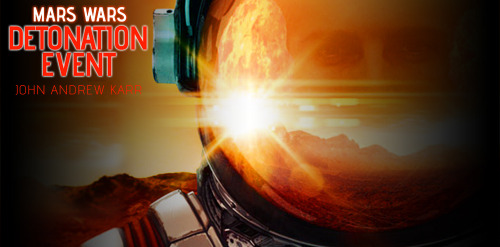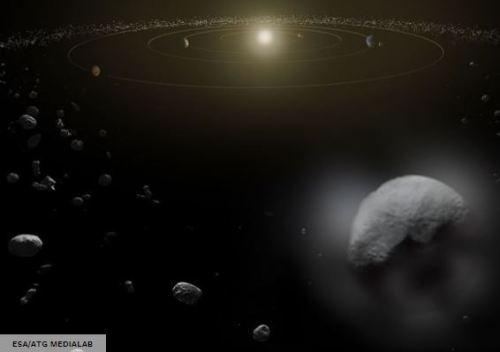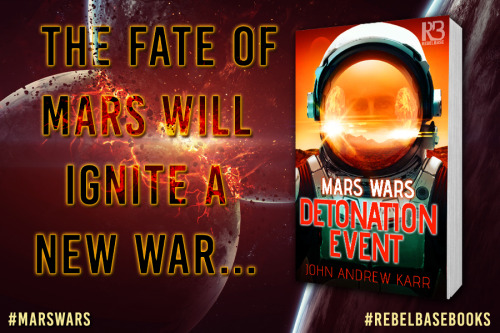A Case for Space, and Mars by John Andrew Karr Tuesday, 05 February 2019
People of Earth.
You know the phrase.
The following is a guest blog by MARS WARS: DETONATION EVENT’s author @johnandrewkarr.

People of Earth.
You know the phrase.
Unless you totally eschew science fiction or science fantasy in all its forms, you know the phrase. If you have disdain for the mind-expanding genres, then you probably fall into the space and Mars haters club despite indulging in space-related technologies, i.e. satellites, portable computers, computer mice, artificial limbs, camera phones. There’s a bunch more that can be found by searching, but this link has a good starter list: https://go.nasa.gov/2Gbxecu

As for the famous Tang—for those of us in our fifth century of existence, or beyond—it was not developed for space travel, but the moon missions made it a big star.
If you’re less seasoned, send a mindtext to your favorite search engine on the galaxynet.
No access to galaxynet?
That’s okay—thirty years ago only a few innovators had access to linked servers that would someday grow to become the internet.
Galaxynet is internet for the solar system. It will have satellite boosts between Earth and Mars, Earth and Jupiter’s moons, and any place we deploy large-scale space stations such as the Mars Orbiters in my Mars Wars series, part of the Rebel Base imprint from Kensington Books.
The timeframe for Mars Wars is near-future, approximately two hundred years from now. MOS-1 and MOS-2 are host to workers and vacationers of around ten thousand people, and serve as forward operating bases to colonization. Self-sufficient, they manufacture air, water, food, clothing, energy pellets, and hydrogen propellant for its nuclear fusion engines and those of the planetary shuttles. The latter are used to fly missions to the Martian surface, or back to Lunar One or Earth.
No story is entertaining without some form of conflict.
The conflict in Mars Wars involves two parties. Those people who want
all resources for the Earth, and those who are space and Mars
colonization proponents. Such a scenario will hopefully remain fiction,
but glimpses can be had on a … less dangerous … scale in human societies
now.
Back to current day, liberty has been taken to toss the
internet into space-related tech. Mostly because Elon Musk’s Space X are
creating a satellite internet that may ultimately lead to WiFi
availability in the most remote crack of Earth’s continental crust.
Others have also started in on similar ventures. More later on
billionaires making a play for serious and profitable expansion beyond
Earth.
People of Earth.
If you’ve ever had even a slight taste of science fiction, you know the phrase. Usually its uttered by some alien who’s come to our beautiful blue planet for war, to pilfer our resources, or simply snatch a few dozen of us to make people patties, under the guise of a beneficial meet-and-greet.
Cunning aliens.
Isn’t it enough to reduce our scientific and engineering advances to stone tool status in comparison with alien tech?
The Peeps of Earth phrase can also be extrapolated to encompass all humans, ever, throughout time. That’s every human born, ever. All who inhaled air, drank water, felt the planet’s mass beneath their feet, gazed up the glorious sun and stars and someday later, died. Of these billions, every single one lived their lives bound to the Earth.
Question: Besides the same relative arm strength, what do Tyrannosaurus rex and Homo sapiens have in common?
Answer: Extinction impotence.
Even non-sci-fi types know how vulnerable we are as a species, and there’s not a damn thing we can do about it.
By the way, the latest thinking for T-Rex is that it could actually rip a human’s arm off in an arm wrestling match, provided it could move its teeny arms side-to-side. So don’t go up to one and call it an arm-wuss or something.
Let’s go ahead and summon one of the first things that come to mind whenever dinosaurs are evoked: asteroid. One big enough to eject millions of tons of ash and dust into the atmosphere, all but blocking out the sun and creating a perpetual ‘asteroid winter.’ A certain percentage of the population might be able to survive the apocalypse for a while, but it could take hundreds or even thousands of years for the skies to clear.
Humans, along a huge percentage of other terrestrial and aquatic life, would most likely perish from famine, disease, and war. There’s a good chance asphyxiation has a role; immediate dispersion of breathable air erupting through the magnetosphere and lost to space. Darkness then withers plant life en masse, along with their oxygen-creating capabilities.
Maybe it won’t be an asteroid for humans. Maybe it will be the very real threat of nuclear war, standard war, or disease. Dinosaurs as a species lasted millions of years. Humans have come far in a blip of comparative time, but we’re also prone to war.
Regardless of method, both species met or will meet their ultimate end on Earth.
Is it of any consolation that astronomers will likely be able to track the instrument of our demise through space as it hurls toward us?
Question: How much does Earth care about the life that clings to it?
Answer: Every bit as much as any other rock in the universe.
Snark aside, only life cares about life.
Obvious, yet worthy of a moment of reflection. Despite radioactive cores that provide a magnetosphere to prevent the escape of air and water to space, Earth and every other planet, moon, asteroid, comet, and yes, even the stars, are not alive. None of the aforementioned are thinkers. They have zero intelligence capability. They do not feel anything. The earth is a fantastic and sometimes terrible host of abundant life, but it lacks the capacity to acknowledge anything, and therefore has no care whether life exists or not.
It has no care whether it exists or not.
Grass has more regard for its life than a planet has self-awareness. The roots will grow toward moisture, the blade toward the sun.
The life forms of Earth care—at least on some fundamental level—but not the planet itself.
Question: What is the only life form that could prevent a total extinction event?
Answer: Look in the mirror.
Probably not you specifically, or me, or anyone alive right now. But perhaps our descendants, unseen over our shoulders in generation after generation on an extended scale, reaching centuries into the future. They could have some contribution toward preserving our species, or the next iteration of it.
The obvious difference between humans and all of the extinct, single-planet-dwelling species that have come before us is that we can build upon current technologies to at least try and thwart the inevitable catastrophe.
Humans alone—unless cockroaches or some other species survive our warring nature and evolve to our current levels—have the means to bump our potential survival rate by 100% by colonizing another planet.
For that, the red planet is a beacon in the night sky. As with any venture into space, the mission is fraught with danger. But Mars as a cold and rocky planet is still preferable to an ice-encrusted moon of Jupiter.
If we ever do figure out a way to kick-start the Martian cores into creating a magnetosphere, as I write of in Mars Wars, or thicken the Martian atmosphere enough to hold air and water, the potential for agriculture is there because of soil. We may need to scrape off the solar wind-pounded surface material and turn it over, but ice, with Jupiter as a backdrop, isn’t going to be kind to the roots of space tomatoes.
Perhaps we’d even import some of the massive sandworms from Frank Herbert’s Dune to help fertilize. Everyone knows Dune is easier to reach from Mars than it is from Earth.
To perform more space outreach, we’ve got to go faster at a sustained clip. Warp drive would be incredibly convenient, but we’ve got a huge knowledge gap between chemical rockets and light speed. If I had to choose a single category to improve immediately, it would be propulsion. It takes us too long to reach anything, and that’s just in our own backyard.
In Mars Wars, planetary shuttles and remote orbiters make use of nuclear fusion for propulsion. It is a cleaner, more sustainable burn that can use hydrogen as a propellant. They can reach Mars in a month, as opposed to nine. Not warp speed or hyper-drive, but a big step in the right direction.
Think how far we’ve come in the preceding two centuries. Who knows where we’ll be two centuries from today, if we make concerted efforts.
But what to do once there? Live forever inside enclosures, or take steps to terraform Mars so it is not immediately hostile to life?
Some space advocates want to keep Mars as a planetary park, unchanged by human hands.
There is no reason to keep Mars in its current state of death. Billions of years ago, Mars once held water and therefore some form of air. There are many reasons to resurrect it.
As seen in Mars Wars, Mars has threats beyond the frigid temps and lack of air and water. What we might find in the soil could be positive or negative, for instance. Click here: http://bit.ly/2GblvKU

Question: What about caring for the earth?
Answer: The two are not mutually exclusive.
Of course we should care for the mother planet, but that doesn’t mean we can’t expand into space and Mars at the same time. Resource drainage from Earth can be limited, and life on Earth can improve with technological advances.
Space expeditions must be commercially viable, or at least self-sustaining. NASA and other government agencies have done great pioneering work, but taxes alone cannot continually fund space exploration. We’re already seeing private ventures from billionaire visionaries like Musk and Bezos and Branson attempting to bring the space flight industry into a more “mainstream” focus. Bringing rare metals back to Earth could lead to more technology bursts.
Harvesting resources from asteroids would be easier from Mars, since it’s closer to the Asteroid Belt, the farmer’s market of asteroids. A dwarf planet in the belt is blasting water vapor into space for some reason, and it may hold more water than Earth. Amazing. And available for harvesting. Asteroids can be encased in water ice. Others have ammonia ice that could be beneficial in thickening the Martian atmosphere.
It’s a process, but water can be harvested from
minerals on asteroids. Comets would take less processing time, but
they’re free spirits and not clustered nicely in a band like their rocky
counter parts. Formed outside our solar system, comets that can provide
immediate water ice are not subject to the same relative orbiting plane
as the planets and Asteroid Belt. These may be more attainable from
Mars due to readiness more than location.
A couple of fun informative links to check out:

Mars itself may have tons of water trapped in its crust, as was recently postulated in a finding on Earth.
This has touched on a few hints about transforming Mars—terraforming it—into a habitable planet. It could take centuries, or less, or never work at all and we end up creating subterranean cities or honeycomb surface ones encapsulated in redundant plexiglass bubbles threaded with titanium strands.
(That last part is a glimpse of the Lunar One base on the moon in Mars Wars.)
Mars needs heat, water, and air, and we’ll move in.
It’s not been tried by humans, but the powers of the solar system have done it. It may be possible to crash asteroids into Mars, set off a bunch of thermonuclear bombs, create vast mirror farms to reflect more sunlight, or use other methods to greenhouse the atmosphere so it can hold air and water and heat.
There may be enough nitrates on the red planet to use for breathable air, since oxygen is the lesser component. Or maybe there’s some rip asteroids to mine for it.
A lot to cover there, for another time.
If Mars does become viable as a self-sustaining colony, and then network of colonies, and then perhaps the entire planet, wouldn’t it also provide relief to overpopulation on Earth?
For those who want to focus solely on Earth until the extinction event(s) strike, don’t we have a duty to future generations to begin the process of increasing survival odds?
The universe is mind-blowingly vast.
Where is the spirit to attain knowledge? To push the boundaries of what
viable life can be had beyond Earth. Exploring has dangers, but it can
also lead to the betterment of Homo sapiens.

Pre-Order/Buy MARS WARS: DETONATION EVENT here→ http://bit.ly/2GbEWmN
Posted 1 week ago | 3 notes | 0 Comments#science fiction#science fiction novels#space travel#Mars#Rebel Base Books#author guest post#writing inspiration
